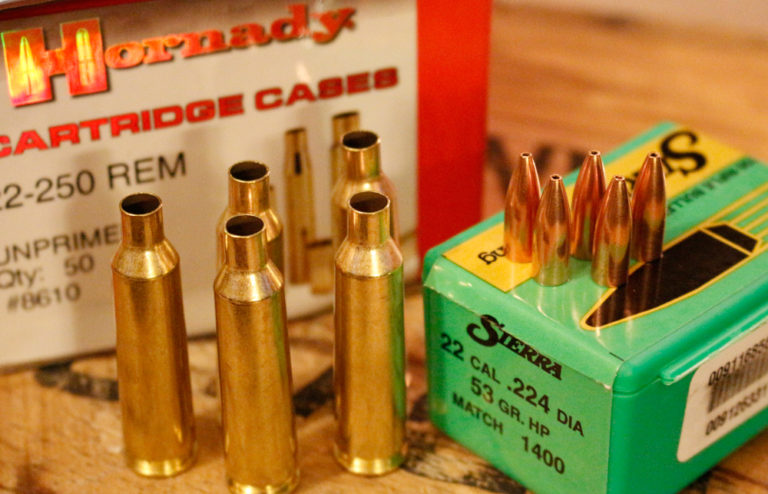

When chewing over potential bullet weights, it is key to take a firearm's barrel twist rate into consideration. It can determine the best bullet for your intended application.
I own and love a Ruger Model 77, in .22-250 Remington.
It has a Hogue overmolded stock, a sweet Timney trigger, and a Leupold VXIII 6.5-20x40AO riflescope, and I love this rifle. But this rifle suffers from an affliction, an affliction that I despise. It cannot shoot bullets heavier than 55 grains. This makes me sad, because if any case could push the 69, 77, 80 grain and heavier .224 bullets, it would be the .22-250 and the .220 Swift.
But, alas, they can’t. Why, you ask? I’m glad you did.
The simple reason that my little beloved rifle is limited to the 55 grainers and under is the rate of twist of my barrel. The standard Ruger twist rate for the .22-250 Remington is 1:14”, so that the bullet will make one complete revolution in 14 inches of barrel length. This twist rate is too slow to stabilize bullets longer than 55 grains; those longer bullets need to spin faster in order to maintain a stable flight pattern downrange.
If the bullet loses its stability, it will start to tumble in flight, and will strike the target in some sort of sideways fashion, leaving a hole in the target much larger than caliber sized. It can resemble the side profile of the bullet; it is better known among shooters as “keyholing”, because the impression on the target looks just like the keyhole of yesteryear.
Bullet stabilization is a funky thing. As bullets get longer they need to spin faster to stay stable in flight. This is the very physical property that has broken, or at least tarnished, the reputations of several great cartridges throughout history.
The .308 Winchester comes immediately to mind. It is my father’s favorite cartridge of all time, and as an inquisitive youth, I looked up the bullet weights and couldn’t figure out why it could use all the .30 caliber bullets, with the exception of 220 grains and heavier. Pop told me it was case capacity, but I found out otherwise. The .30-’06 uses a twist rate of 1:10” and the .308 Winchester uses (or I might say, “used.” Things have changed) a 1:12″, and that slight difference precludes the .308 from stabilizing the 220-grain bullets.
The .244 Remington is another example of twist-rate-mortality. Based on the 7x57mm Mauser case, the .244 could, potentially, drive the 6mm bullets to wonderful velocities. However, the Remington developers used a 1:12” twist rate, which can stabilize 90-grain bullets at the heaviest.
As the 6mm bores were conceived as a dual-purpose deer/varmint round, shooters wanted to utilize the 100 and 105-grain bullets for deer. The .243 Winchester, based on the smaller .308 Winchester (51mm long) case, was conceived with a 1:9” twist, and could stabilize the longer, heavier bullets with no issue at all. The history is written, and the .244, even after the twist rate change and a new moniker of “6mm Remington,” lost the market share and popularity contest long ago.

How do we handloaders use this information for our purposes? Sometimes, when looking at a particular bullet to play with, we should know whether or not the case (and barrel) we are loading for can handle it.
Berger Bullets has a twist rate calculator on their website, and it can be very handy. Firstly, you need to know the twist rate of your barrel. Using a cleaning rod and a tight patch, you can make a mark on the top of the rod, and measure the distance along the rod once it makes one full revolution. Knowing the twist rate of the barrel, you can plug in the data and the calculator will tell you the bullet weights that you twist rate and caliber will stabilize best.
After all, there’s no point in throwing lead knuckleballs after you’ve loaded all that ammo so carefully.

Next Step: Get your FREE Printable Target Pack
Enhance your shooting precision with our 62 MOA Targets, perfect for rifles and handguns. Crafted in collaboration with Storm Tactical for accuracy and versatility.
Subscribe to the Gun Digest email newsletter and get your downloadable target pack sent straight to your inbox. Stay updated with the latest firearms info in the industry.

![Best Concealed Carry Guns In 2025 [Field Tested] Wilson Combat EDC X9S 1](https://gundigest.com/wp-content/uploads/Wilson-Combat-EDC-X9S-1-324x160.jpg)


![Best 9mm Carbine: Affordable PCCs [Tested] Ruger Carbine Shooting](https://gundigest.com/wp-content/uploads/Ruger-Carbine-Shooting-100x70.jpg)
![Best AR-15: Top Options Available Today [Field Tested] Harrington and Richardson PSA XM177E2 feature](https://gundigest.com/wp-content/uploads/Harrington-and-Richardson-PSA-XM177E2-feature-100x70.jpg)

I made the same mistake years ago. In ’69 when I was 16 I built my first custom rifle, it was in 25-06, pre-war mauser 98 action, Douglas barrel and Bishop stock. Turned out beautiful, the only problem was I didn’t really know anything about twist rate and I got the barrel in 1-12. It will not shoot anything over 100 grains. I’ve shot crow at 500 yards with 90 grainers and dropped many an eastern whitetail with 100 grainers but a 115 will keyhole a 50 yards no matter how hard I push it. I’ve considered, after all these years, about rebarreling it to a 1-10 but I’ve got tack driving loads for this barrel and as much as I love load development I don’t want to start all over again with a rifle I’ve shot so well with for so many years
.